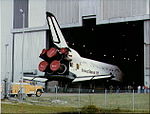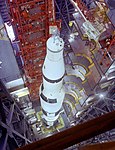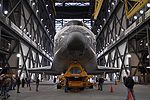Vehicle Assembly Building
Vehicle Assembly Building (VAB), är en monteringshall för USA:s raketprogram och finns på John F. Kennedy Space Center i Florida. Byggnaden invigdes 1966.
Under den tid som Apolloprojektet pågick stod VAB inte för Vehicle Assembly Building utan för Vertical Assembly Building.[1] Hela lokalen är byggd för att sätta ihop Saturnusraketerna stående och därför fick den benämningen Vertical. När det senare blev monteringshall för rymdfärjan ändrades namnet till Vehicle Assembly Building.
För att kunna bygga de höga Saturnusraketerna under Apolloprogrammet var man tvungen att bygga en monteringshall. Den är 160 meter hög, 218 meter lång, 158 meter bred och täcker en yta om 3,25 hektar. Ett tag var den världens största byggnad, men de 139 meter höga dörrarna är fortfarande världens största och tar 45 minuter att öppna.[2]
På utsidan finns NASA:s logotyp och USA:s flagga. För att förstå byggnadens storlek är varje stjärna i flaggan (50 stycken) 1,83 meter höga; flaggan är 63,7 meter hög och 33,5 meter bred. Flaggan sattes upp 1976 som en del av USA:s 200-årsfirande. NASA:s logo sattes upp 1998.
Byggnaden är så stor att fuktiga sommardagar kan det bildas regnmoln vid taket inuti byggnaden.[3] Byggnaden har ett fläktsystem för att skingra molnen och undvika regn i byggnaden.
Galleri
- Vehicle Assembly Building
- Rymdfärjan Discovery på väg ut genom de gigantiska dörrarna.
- Apollo 10 på väg från byggnaden.
- Rymdfärjan Columbia rullas ut från byggnaden.
- Rymdfärjan Columbia rullar in för underhåll.
- Apollo 4 byggs.
- Rymdfärjan Atlantis är inne för underhåll.
- Rymdfärjan Atlantis rullas ut ur byggnaden.
Referenser
- ^ ”Arkiverade kopian”. Arkiverad från originalet den 11 september 2008. https://web.archive.org/web/20080911092613/http://www.hq.nasa.gov/office/pao/History/SP-4204/notes11.html. Läst 31 mars 2009.
- ^ Världens historia nr 11 2007
- ^ http://lsda.jsc.nasa.gov/docs/kids/L&W/glossary.cfm Arkiverad 1 november 2007 hämtat från the Wayback Machine. NASA
 Wikimedia Commons har media som rör Vehicle Assembly Building.
Wikimedia Commons har media som rör Vehicle Assembly Building.
Media som används på denna webbplats
RKennedy Space Centre, Florida - Space Shuttle Atlantis, on top of its transporter, rests in the transfer aisle of the Vehicle Assembly Building after the rollover from the Orbiter Processing Facility.
KENNEDY SPACE CENTER, FLA. -- Daylight streams through the open doors of NASA's Vehicle Assembly Building as Space Shuttle Discovery begins its slow 4.2-mile journey via the crawlerway to Launch Pad 39B. The shuttle rests on a mobile launcher platform that sits atop a crawler-transporter. First motion was at 12:45 p.m. EDT. The rollout is an important step before launch of Discovery on mission STS-121 to the International Space Station. Discovery's launch is targeted for July 1 in a launch window that extends to July 19. During the 12-day mission, Discovery's crew will test new hardware and techniques to improve shuttle safety, as well as deliver supplies and make repairs to the station. Photo credit: NASA/Kim Shiflett
Space Shuttle Columbia rolls out from the Vehicle Assembly Building on its way to Launch Pad 39A. Columbia sits atop the Mobile Launcher Platform, which in turn is carried by the crawler-transporter underneath for the long, slow journey to the pad
Columbia being transferred from the Orbital Processing Facility to the Vehicle Assembly Building in preparation for STS-5 mission. Security personnel (foreground) at the Kennedy Space Center watch as the Space Shuttle is moved
Space Shuttle Atlantis begins rolling out of the Vehicle Assembly Building to Launch Pad 39A.
Saturn V Vehicle for the Apollo 4 Mission in the Vehicle Assembly Building
This photograph depicts the Saturn V vehicle (SA-501) for the Apollo 4 mission in the Vehicle Assembly Building (VAB) at the Kennedy Space Center (KSC). After the completion of the assembly operation, the work platform was retracted and the vehicle was readied to rollout from the VAB to the launch pad. The Apollo 4 mission was the first launch of the Saturn V launch vehicle. Objectives of the unmanned Apollo 4 test flight were to obtain flight information on launch vehicle and spacecraft structural integrity and compatibility, flight loads, stage separation, and subsystems operation including testing of restart of the S-IVB stage, and to evaluate the Apollo command module heat shield. The Apollo 4 was launched on November 9, 1967 from KSC.
Aerial view of Kennedy Space Center's Vehicle Assembly Building, with vertical U.S. flag and the emblem of the 1976 bicentennial celebrations















